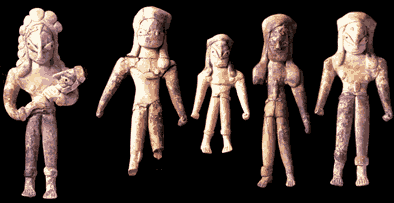
 |
|
Before the rise of the Indus Civilization, terracotta figurines representing females in a variety of shapes and forms were made in Balochistan. They were probably used in fertility rituals intended to ensure a rich harvest and the well-being of domestic animals, but they may have had other functions as well. Regardless of the period or the craftsmanship, these early figurines portray seated humans (or deities) with exaggerated lower torsos (buttocks) and/or upper torsos (particularly the breasts), perhaps as an expression of the desire for the fecundity of plants, animals and people. |
|
|
Male figurines appear for the first time at Mehrgarh and at the nearby site of Nausharo in the hills of Balochistan circa 2700 B.C., the period immediately preceding the establishment of urban civilization in that area. The appearance of male figurines may symbolize a change in the spiritual world or in social authority. Males are usually depicted wearing a turban and standing on very straight legs, and some have slit or half-opened eyes that are similar to those of the so-called "Priest King" of the Indus Civilization. |
|
[home] [prev] [next] |
|
| [Environment] [The dawn of civilization] [Indus Civilization] [The successors] | |

